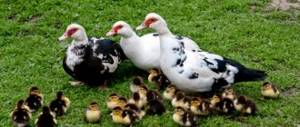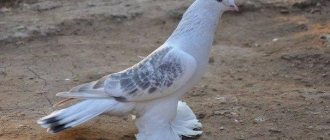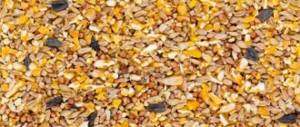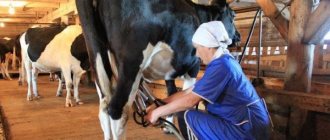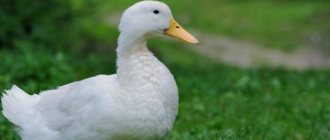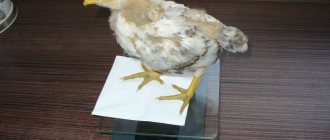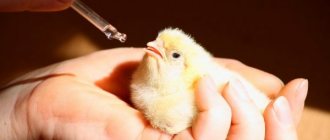Features of birds
There is no such thing as a broiler breed in science. In the professional literature, farm broiler breeds are called crosses or hybrids. Like plants, birds have absorbed the best parental qualities that they cannot pass on to their offspring.
Farm-bred broiler chickens quickly gain weight and are slaughtered by 3 months. Unlike adult individuals, they have tender dietary meat, devoid of a specific species taste. You can get more product from one carcass than from regular farm chickens.
They have high productivity and are quite easy to maintain in artificially created conditions.
Representatives of the cross are recognized by their large size. At the age of 2 weeks, chicks gain at least 1.5 kg, and by 5 months they weigh from 4 to 5.5 kg. The main features are:
- short limbs;
- compact body;
- calm character.
Egg production in hybrids is poorly developed, although females hatch chicks well. Phlegmatic hens do not run away from the clutch and, without whims, complete natural incubation to the end. The most common problem of the species is falling on its feet due to rapidly increasing weight.
Features of broilers
Broiler chickens are distinguished from ordinary chickens by their large size and intensive gain of muscle mass, due to genetics. If a regular chicken at the age of 2 weeks weighs no more than 0.5 kg, then a broiler chicken by this time can weigh more than 1 kg. Adults (5–6 months) reach a weight of 4–4.5 kg, and sometimes more than 5 kg.
Their productivity depends on what breeds of chickens are crossed to produce broilers. Since the main goal when breeding crosses is to obtain meat, the egg production of these birds is low, but the hen instinct is well developed. Among the disadvantages, we can only note the fact that broilers are not able to pass on their positive qualities by inheritance, therefore their offspring are often weak, and crossing with each other is not practiced.
Read also: Placing a chicken coop on the site
Best breeds
Every year new highly productive crosses appear, so it is quite difficult to decide which breeds of broiler meat are best to grow. Below are descriptions and maintenance requirements for several breeds that have remained popular over recent years.
This breed belongs to English selection. This is an ideal choice for small farms, as it combines good egg production (more than 180 eggs/year) with high meat performance. The daily weight gain of young animals is 55–60 g, and chickens reach a weight of 2.5 kg at the age of 2 months. The birds are unpretentious and are able to breed fully viable offspring, which rarely happens in broilers.
Not all consumers like the light color of the skin of carcasses, but this does not affect the taste in any way.
Broilers of this breed are distinguished by their large carcass size and beautiful yellow skin, which is especially liked by consumers. The cross is characterized by early maturity and rapid growth in live weight - at the age of 1.5 months, young animals weigh 2.5 kg and are ready for slaughter. It is also worth noting the high survival rate of chickens - 97%. However, the productivity of chickens greatly depends on the conditions of detention, diet and quality of feed.
If you are interested in which breed of broiler is the best for obtaining and selling meat products, then this is undoubtedly ROSS-708. Subject to proper maintenance (diet, light and temperature conditions), young animals reach a weight of 3 kg in just 35 days. Chicken carcasses are round, with a wide breast and short powerful legs, but the skin, again, is white. Chickens easily adapt and get along with other birds, which has made this breed the most popular among broilers.
Broiler 61
A positive feature of this cross is considered to be a high coefficient of live weight gain with low feed costs. To grow 1 kg of meat, a chicken requires only 2 kg of feed, and with this diet it reaches a weight of 2 kg by the age of 1.5 months. The birds are undemanding in terms of maintenance, and the survival rate of young animals is 98%. However, due to the intensive growth, the chickens remain weak for a long time, and if you need to raise them to adulthood, you will have to tinker.
The egg production of chickens is average (140–150 eggs), but the meat is of high quality and unique taste.
This is a multilineal hybrid, for the breeding of which it was necessary to cross two types of chickens on the paternal and maternal lines. The cross is not distinguished by its intensive growth (daily weight gain is 30 g) and large size - a six-month-old rooster weighs only about 1.6 kg, and a hen weighs even less (up to 1.3 kg). However, the carcass of these broilers looks very attractive: the yellow skin and a large amount of subcutaneous fat puts it on the same level as a homemade product.
Cross Change
This is a domestic hybrid, bred on the breeding ground of the same name. In terms of productive characteristics, it is considered universal - it combines good weight gain (up to 50 g/day), stable reproduction and good egg production (140–150 eggs annually). Unlike foreign crosses, these birds are perfectly adapted to domestic conditions. Chick viability is 97%, but in the first days they require a temperature 2–3 °C higher than other broilers.
If we compare this cross with other meat hybrids, we can say that these are meat-egg birds. They have little muscle mass and a compact build (adults weigh about 3 kg), but good reproduction and egg production. From one chicken per year you can get about 160 eggs weighing 65–70 g each. Chickens are unpretentious and feel comfortable in cages, which allows them to be kept in factories and farms.
Cross Hubbart F 15
Foreign selection
The first breeds of broiler chickens were bred in England. Farmers have noticed that by crossing individuals of different meat breeds, they can get chickens that grow quickly and gain weight. Which hybrid is better? Let's look at the main favorites.
ISA F15
The Isa Hubbard is an original French breed that is extremely popular among meat producers. Compact chickens with a small head have white plumage and yellow skin pigmentation. Females have a wide, muscular chest, while males have a medium chest. Strong paws easily support the weight of the hybrid.
What makes this special breed unique? Professionals classify the broiler as a meat-egg type. In addition to delicate products, the farmer also receives high-quality large eggs. If you create favorable living conditions and provide your pet with adequate nutrition, the bird can be kept without problems.
The description of the cross states that all individuals demonstrate excellent weight gain without significant costs. Thanks to their compact body, chickens are survivable. Chicks quickly adapt to any climate, so they are in high demand.
By week 7, females reach 2.6 kg, and males - almost 3.5 kg. Many farmers slaughter their livestock when they are one month old. This feature saves feed, allowing you to receive finished products much earlier.
Arbor Acres
Are there new breeds of broilers? Recently, the Arbor Acres hybrid has become popular among farmers. It belongs to the Isa Hubbard group, but has some distinctive features.
The characteristic says that cross-country chickens are large birds with white feathers and yellow skin. The massive skeleton easily carries a huge mass. Individuals have strong short legs and very developed legs and thighs. On a small neck there is a medium head with a leaf-shaped crest.
The breed is considered one of the best and most productive. Chickens quickly build muscle, so by a month their weight reaches almost 2 kg, and after 10 days - 3. Patient farmers can get huge carcasses that increase up to 6000 g. Low-calorie meat has a subtle sweetish taste and does not cause allergies.
When purchasing chicks, you should remember their weaknesses. Often the videos only talk about the pros, forgetting to indicate the cons. In order to grow crosses without problems, you need to take into account the heat-loving nature of the birds. At the slightest temperature fluctuations, the young animals become “sad” and fall ill. Those who want to get the most out of it should think about suitable content.
Master Gris
An interesting foreign cross, which is used both as a source of meat and for the production of eggs. French breeders obtained an unpretentious and hardy bird. With proper care and maintenance, the survival rate of chicks is close to 99%.
The characteristic states that roosters can reach 7 kg, and females - almost 4 kg. Pets have tasty juicy meat without extraneous aromas and low fat content. Unlike other broilers, representatives of the species begin to lay eggs at 28 weeks, their productivity is up to 300 pieces per year.
A characteristic feature of the variety is the color of the plumage. Most often, meat crosses are white, but Master Gris chickens will surprise you with a mixture of gray shades. The pockmarked, well-fed specimens can live both in cages and in enclosures.
General characteristics of broiler breeds
Every year, thanks to the crossing of meat types of chickens, breeders develop new breeds of broilers or, in other words, crosses. It is very easy to distinguish them from ordinary chickens - all types of broilers have particularly large carcass sizes. Ordinary chickens, which gain only half a kilogram by 1.5 weeks, cannot be compared with broiler chickens, which weigh one and a half kilograms at the same age.
As a rule, broiler chickens of all breeds are fattened for no more than 1.5-3 months and sent for slaughter. Keeping them longer is not economically profitable, because after this period the bird’s growth practically stops.
The concept of “cross” should be distinguished from the concept of “breed”.
The main difference between them is that it is impossible to obtain chicks from cross-breed eggs that retain the high-quality characteristics of their parents.
There are a large number of broiler breeds in the world. New breeds appear periodically, the previous ones become obsolete and cease to be popular. The most common meat and meat-egg breeds are: COBB-500, Sasso XL 551, Hubbard, Isobraun, Redbro, Naked Neck, ROSS-308, Tricolor, Hungarian Giants.
But still, which breed of broiler is the best and most productive? Let's try to figure it out.
Broiler breed KOBB-500
KOBB-500 broilers are characterized by a powerful build, wide chest, and fairly large paws. The plumage of the birds is snow-white; above the strong beak of both cockerels and hens there is a medium-sized bright red crest. The earlobes are the same color.
Czech broiler is in constant demand among farmers. The reason for this is the rapid gain of body weight with low feed consumption. When keeping roosters and hens together, by 40 days the average weight of the bird will be approximately 2.45 kg, and by 56 - 3.64, while the average productivity of this breed in different countries of the world differs slightly.
Caring for this type of broiler is standard. They can be propagated either in cages or in floors. Be sure to keep the chicken coop clean and provide good ventilation. In the diet of birds, the main place is occupied by food rich in protein, which ensures rapid weight gain.
Broiler Arbor Acres
Arbor Acres broiler is one of the most efficient in the world. Has excellent growth rates with minimal feed consumption. 35-day-old birds weigh 2 kg, and by the 42nd day of life this figure approaches 3 kg. The carcasses of birds of this breed have an attractive pale yellow color.
Read also: Making your own chicken coop at your summer cottage
Arbor Acres has a well-developed musculoskeletal system, a large fleshy carcass, and medium-length legs and neck. The birds have a leaf-shaped crest and white plumage.
Arbor's special feature is the unpretentiousness of the chickens and the rich, slightly sweet taste of the meat.
The best broiler breeds: description with photos, main characteristics
Breeds of broiler chickens are popular in households and on farms, valued for their high productive meat qualities. Broilers or crosses are the result of crossing different breeds of chickens, from which they take the best qualities. Under good conditions, in just one and a half to two months, a chicken can grow and gain weight up to one kilogram.
At the same time, the meat will turn out tasty, tender and juicy. The disadvantages of broiler chickens include their inability to pass on their acquired positive qualities by inheritance.
Main characteristics of broiler chickens
Breeding crosses includes two important components - they must have good meat maturity and egg production. Meat is obtained from young birds. Until adulthood, they are raised only for the purpose of producing eggs.
General characteristics of broilers include:
- Quite a lot of weight. An adult male can reach a weight of 5.5 kg, and a female can weigh about 4.5 kg.
- Large body size.
- Short wings and legs.
- Rapid muscle gain.
- Low egg production.
- Well developed brooding instinct.
- Phlegmatic temperament.
Feeding broiler chickens
Since broiler chickens grow intensively , their maintenance has its own characteristics. Young animals should be fed well, so that by the age of two months each individual can gain at least one and a half kilograms of live weight.
For the first ten days, chickens are fed about eight times a day , that is, approximately every two hours. The night feeding break should not exceed six hours. The diet of young animals should include easily digestible protein in the form of boiled eggs, milk, and cottage cheese. From the fifth day of life, crushed eggshells can be given. Gradually, the diet is expanded, and the chickens begin to be fed with crushed wheat and corn grits.
On the tenth day of life, young animals should be given a vitamin-grain mixture consisting of the following ingredients:
- 5% oatmeal;
- 10% barley flour;
- 10% chopped scalded nettle;
- 25% crushed wheat;
- 50% corn flour.
At two weeks of age, well-cooked meat , grated carrots, and chopped herbs are introduced into the diet. In addition, it is necessary to install an additional feeder, which should always contain ground shells, gravel, chalk, bone meal or other mineral feed.
From the twentieth day of life, chicks are transferred to feed adult birds . Until then, they should be given special attention. During this period, young animals drink a lot, so each individual must be provided with 40 grams of liquid per day. Otherwise, the bird can quickly develop dehydration.
Broilers of the Smena breed
The cross was bred by specialists , in whose honor it received its name. This fairly popular breed was the result of crossing broiler birds of the Gibro-6 and Broiler-6 breeds.
Chickens have a high growth rate , gaining up to 50 grams in weight every day. The viability of young animals is at least 97%. Chickens of the Smena breed have a lot of advantages:
- high meat quality;
- good egg production up to 140 eggs in 450 days;
- high viability;
- excellent taste.
When keeping chickens of this cross, it should be taken into account that in the first days of life they should be provided with an air temperature two to three degrees higher than what is customary for all broiler chickens.
The best breeds of broiler chickens to raise
Before moving on to the description of the breeds, it is worth highlighting a number of characteristics characteristic of all birds of this direction:
- the body is more massive compared to ordinary chickens;
- large weight of about 4.5 kg for adult chickens and about 5.5 kg for adult roosters;
- the physique is dense, has a horizontal stance;
- egg productivity indicators are low, but laying hens are not devoid of maternal instinct;
- birds, for the most part, have an easy-going character;
- limbs and wings are short;
- rapid gain of muscle mass in young animals.
Breed Smena
This cross was bred by specialists at the poultry farm of the same name. Today, chickens are very popular among breeders involved in the production of meat products. It was possible to obtain a new hybrid thanks to the broiler breeds Gibro-6 and broiler-6.
The young of this breed can boast of rapid growth: chickens gain up to 50 grams in weight per day. Young animals have a high percentage of vitality - no less than 97%. Shift representatives have a large number of positive qualities:
- very tasty meat;
- good egg production, in 450 days you can get up to 140 eggs;
- high livestock viability.
Note to poultry farmers. If you plan to keep chickens on a farm, you need to remember that during the first few days of life, the chicks will require a higher temperature regime compared to other representatives of broiler varieties.
Gibro-6
The breed is four-line, in its creation: from the father's line there are Cornish dogs (2 species), from the mother's line - white Plymouth Rocks. Hybro-6 roosters at six months of age gain weight of 1.5 - 1.6 kg, hens are somewhat smaller, their weight is 1.3 kg.
The survival rate of young animals that have reached the age of 49 days is very high - 98%. Representatives of the breed have yellow skin, which makes the carcasses attractive to buyers. Chickens with a well-developed layer of subcutaneous fat, dense plumage, leaf-shaped comb. Among the advantages are the following:
- good rate of muscle mass gain - the bird gains at least 30 grams per day;
- good indicators of egg productivity - in 400 days - up to 160 eggs;
- good taste, both in meat products and in egg products;
- birds have a balanced and calm character.
Worth knowing. When growing this hybrid, it is necessary to introduce a restriction on the amount of feed for young animals that have reached the age of 1.5 months. Portions are reduced and efforts are made to provide less calorie foods. Otherwise, individuals become very fat.
Broiler-61
This cross is widespread among domestic poultry farmers; the breed also belongs to the four-line breed. On the paternal side two Cornish breeds were used, on the maternal side they took Plymouth Rocks.
Young animals quickly gain weight with little input of feed resources. To raise an individual weighing 1000 grams, you will need to spend 2.2 kg of food.
Among the advantages of representatives of this breed are:
- young animals have a high survival rate - 98%;
- a bird at one and a half months of age weighs 1.8 kg;
- good quality meat products;
- broilers-61 have a peaceful and calm character.
Broiler - m
Such chickens are classified as meat-egg breeding. The cross was bred using dwarf representatives of various breeds and some hybrids. The average weight of an adult is approximately 3 kg. In 365 days, chickens produce 150 – 160 eggs with an average weight of 1 egg of 65 grams. Individuals reach sexual maturity at 150 days.
Among the positive aspects of the breed, the following traits are distinguished:
- undemanding conditions of detention;
- compact build (poultry stocking density can be increased due to this factor);
- high productivity indicators in both areas;
- calm nature of birds;
- low feed consumption;
- meat products of excellent quality.
Ross – 308
This breed can be considered unique. If you provide birds with the right conditions and a balanced, nutritious diet, the birds will gain 55 grams of weight per day. The formation of muscle mass occurs during the growth of birds.
It is recommended to send Ross dogs for slaughter at the age of 42 – 56 days. At this point, one chicken has an average weight of 2.5 kg. Adult chickens show good egg production; one hen can produce approximately 185 eggs per year.
Representatives of the breed can be distinguished by their snow-white plumage and small stature, compared to other broilers.
Farmers who breed this cross talk about the following characteristics of chickens:
- precocity of young animals;
- good muscle development;
- light skin, this feature makes the carcass attractive to potential buyers;
- high performance.
Cobb – 500
The main feature of broilers is the presence of yellow skin, even if there is no pigmented food in its feed. Chickens have snow-white plumage and have a good growth rate.
The best age for slaughtering cobbs is 40 days from birth. At this point, broilers gain weight of 2.5 kg. It is common for chickens to gain muscle mass and grow quickly.
Positive traits:
- rapid weight gain;
- low cost of final meat products;
- limbs are large and well developed;
- excellent livestock survival rates.
A properly selected diet will help reveal all the qualities of the breed. In order for chickens to develop muscles well, intensive feeding of the livestock should begin from the first month from the moment of hatching.
Broilers Cobb 500 and Ross 308: video
Ross – 708
The cross was bred not so long ago, but in terms of productive indicators they are many times superior to Ross - 308 and Cobb - 500. Representatives of the new breed are early maturing, and in the first 30 days of life they gain weight of 2.9 kg. It is for this quality that poultry farmers love broilers, but they also have other positive characteristics:
- large and powerful limbs;
- a large number of meat products;
- low feed consumption;
- high percentage of livestock survival;
- quickly adapt to new conditions of detention.
Arbor Acres
This broiler variety was developed jointly by the French, Americans and British. Birds have rapid maturity and other positive traits, due to which their popularity among breeders is growing.
At the genetic level, arbors have beautiful yellow skin. Such birds will not need a special diet containing food containing coloring pigments. In any case, the carcass will have an attractive presentation.
As mentioned above, the young animals are very precocious, and at the end of 30 days from the moment of birth, representatives of the breed are able to gain a weight of 2 kg, then intensive weight gain begins, and after another 10 days the broiler will have a weight of 3 kg.
Note to the poultry farmer. Meat products from Arbor are low-calorie and non-allergenic, and therefore can be used as food for people prone to allergic reactions.
Arbors and eggs are produced, although only from the 32nd week of life; in 365 days up to 120 eggs are obtained from one individual. Chickens lack maternal instinct.
Hubbard
Representatives of this cross are able to gain weight of 10 kg. But in order to get such a significant weight, the farmer will have to follow the feeding regime on the farm and carefully select food for the chickens. On average, Hubbards weigh 5–6 kg, but if you wish, you can increase these numbers.
You can distinguish broilers from other breeds by the following characteristics:
- average build;
- well developed muscles;
- roosters have a narrower chest than hens;
- color – white;
- chickens develop plumage earlier than roosters;
- color of comb and earrings – pink;
- The limbs are short, but strong.
Representatives of the breed gain the weight required for slaughter by the 60th day of life; it ranges from 2.7 to 3.2 kg.
When arranging a room for Hubbards, you need to remember some nuances:
- humidity indicator – 70%;
- recommended temperature +32°C (for chickens under 35 days of age);
- upon reaching the age of 5 weeks, the temperature is gradually lowered, observing an interval of 5 days;
- the minimum threshold in the poultry house is +18°C.
Important point. Failure to comply with at least one of the above conditions leads to the fact that the young animals begin to grow worse, and the well-being of the birds worsens.
Growing Hubbard broilers: video
Cornish
Broilers were bred in England, and the breed was originally presented as a fighting breed. Experts wanted to obtain individuals intended to participate in fights, with an aggressive character and an appropriate physique. However, at some point, breeders discovered that the chickens lacked a number of traits necessary for fighting chickens, so the Cornish became a meat broiler.
Birds have the following qualities:
- Young animals can be slaughtered at two months of age, when they weigh 2 kg. The maximum weight is reached by six months of age. Individuals weigh under 4 kg;
- To obtain young animals, you do not need to use an incubator, because chickens have good maternal instinct;
- good egg-laying qualities: in 365 days 140 eggs, the weight of one is from 55 to 60 grams.
Tricolor
The breed was bred in France; the character of broilers is quite calm. Birds rarely get scared and in a short time get used to having a person next to them. Another feature is inactivity; chickens simply will not waste their energy. Tricolors adapt perfectly to various living conditions, be it cage batteries or a not very high-quality chicken coop.
Compared to other breeds, the Frenchies have a unique color and very good egg production. In 365 days, up to 300 eggs are obtained from one chicken; even egg crosses cannot always boast of such qualities.
If special rearing technologies are followed, by the end of the first month of life the birds are able to gain a weight of 1.5 kg. Full maturation, the beginning of laying and growth cessation occurs at six months of age. The maximum weight for tricolors is 5.0 – 5.5 kg.
Sasso
This breed has been known for several decades. Broilers were bred using complex hybrid crossing, however, what breeds the French breeders used in their work do not tell anyone.
Sasso very quickly gained popularity due to some superiority over other broilers. This aroused interest among Americans and Australians, but the French are in no hurry to reveal the parental lines.
As for the weight and time of slaughter, by the 60th day of life, birds gain weight of 1700 - 1900 grams. The egg-laying quality of this breed is very low, no more than 120 - 140 eggs per year. Chickens, as a result of the work of breeders, have lost their maternal instinct and are unsuitable for incubation.
Competitor 3
Broilers have a white coat, smooth feathers, a massive body and a developed chest. Competitor 3 is characterized by the presence of strong and large limbs.
Young animals are distinguished by their early maturity, chickens are famous for their excellent weight gain, in 24 hours the birds gain approximately 50 grams in weight, and upon reaching the age of 6 weeks they weigh 2 kg.
If all housing and feeding conditions are met, representatives of the breed are sent for slaughter at the age of 35 days. If the weight is unsatisfactory, then the broilers are left to grow for some time.
Competitor-3 reaches sexual maturity at 5 months and eggs can already be obtained from chickens, albeit in small quantities. In 365 days - 160 eggs.
Chickens "Broiler-61"
The four-line meat breed , widespread in the central part of Russia and the Volga region, was bred by crossing white Plymouthrock and Cornish chickens. A distinctive characteristic of the cross is the rapid gain of live weight. At the same time, chickens need very little to feed. Only 2.2 kg of feed will be needed to produce a 1 kg bird.
The advantages of the Broiler-61 breed are:
- good survival rate of chickens up to four months of age (98%);
- at one and a half months, young animals can already weigh 1.8 kg;
- good quality meat;
- peaceful and calm character.
The egg production of this breed is average. A laying hen can produce about 160 eggs in a year.
When raising Broiler-61 chickens, you should know that due to the high growth rate, chickens grow stronger rather slowly. Therefore, their development must be monitored. At the age of five weeks, young animals begin to be restricted in food.
How to raise broilers?
Also check out these articles
- Livensky Calico breed of chickens
- Raspberry variety Polka
- Pasteurization of milk
- Low growing tomato varieties
When raising broilers, it is worth studying all their features. Depending on the cross, the bird can be simple or complex in terms of raising and breeding. Thus, “ROSS 308” multiplies quickly. Young animals are distinguished by good health and a high survival rate. “ROSS 708”, in turn, is convenient in terms of cultivation because it eats little, grows quickly, and is unpretentious in terms of care. But the “Hubbard Isa F-15” needs special feeding to achieve large body weight, and this must be taken into account!
Important!
Broiler chickens are characterized by inactivity, they are very calm, so they do not create chaos, do not scream for no reason and do not fight.
So rearing directly depends on the species, but as a rule, broiler chickens are calm, productive and do not cause problems.
Cross "Broiler-M"
A meat-and-egg breed with a compact build was developed by crossing synthetic and mini chickens. A universally productive bird weighs about 3 kg. At the same time, laying hens are capable of producing from 150 to 160 eggs of 65 grams each per year. Chickens reach puberty at the age of five months.
The advantages of the cross include:
- unpretentiousness to living conditions;
- small build, due to which the bird stocking density increases per square meter of the chicken coop;
- high productivity of not only meat, but also eggs;
- calm behavior;
- low feed costs;
- excellent taste of meat.
The Broiler-M breed can be kept in cages and on the floor. It is most widespread in the central part of Russia.
Description of the breed "Broiler - M"
This breed was created on the basis of small chickens (female side) and synthetic birds (male side), which was created by crossing mini chickens and Yerevan reds.
The bird is distinguished not only by its meat production, but also by its egg production. The egg production of one bird is 162 eggs per year .
The weight of one is within 65 grams. Broilers lay their first eggs at the age of five months.
On average, the weight of a rooster ranges around three kilograms, and the weight of a female ranges from 2.4 to 2.8 kilograms.
Positive aspects of the Broiler-M breed:
- The birds have a small build, which allows them to increase their stocking density per square meter.
- Broilers are not picky about their living conditions.
- Broilers are distinguished by their high productivity of both meat and eggs.
- Birds, due to their high productivity, are distinguished by their versatility.
- Birds are distinguished by their calm behavior.
No deficiencies have been identified in the Broiler-M breed.
Chickens "KOBB-500"
The rather large bird is very popular among farmers and poultry keepers. This is explained by the proportional accumulation of live weight with an almost ideal growth rate ratio. White and red meat are proportionally distributed in the carcass. The leather of the cross has a yellowish color, which the consumer really likes.
The positive characteristics of the KOBB-500 broiler include:
- high increase in live weight (in 40 days the bird gains about 2.5 kg);
- strong, large legs;
- excellent survival rates;
- large snow-white breast;
- low cost of meat;
- omnivorous bird.
To obtain the best productivity of the breed, it is necessary to monitor the conditions and quality of feed.
Description of the breed "COBB - 500"
A distinctive feature of this species is the yellow color of the bird, even when it is fed with non-pigmented feed.
Broiler feathers are white, like the previous type of bird.
They have quite intensive growth .
The age that is the best time for slaughter is around forty days.
During this period, the bird reaches a weight of about two and a half kilograms.
Chickens of the COBB-500 breed have very positive characteristics. They gain muscle mass very quickly and grow quickly.
Positive characteristics of this broiler breed:
- Broilers have a high increase in live weight.
- They are distinguished by their low cost of meat.
- Broilers have very large and strong legs.
- They have excellent feed conversion.
- The birds have a snow-white and large breast.
- The broiler breed COBB-500 has excellent survival rates.
- In a flock, birds are homogeneous and do not differ from each other.
No disadvantages have been identified in this breed.
The productivity of the breed is influenced by several reasons, the main one being proper feeding of broilers.
In order for the muscle mass of birds to grow rapidly, they need to be fattened, especially in the first month.
Broiler "ROSS-308"
The chicken breed is highly valued for its unique ability to gain 55 grams of weight per day . However, this is only possible with good feeding and maintenance of the bird.
The muscle mass of the broiler "ROSS-308" begins to form from the very beginning of the growth of chickens. It is recommended to slaughter them at a weight of two and a half kilograms, which they reach at the age of six to nine weeks.
The advantages of the cross are:
- rapid growth of the bird, which makes early slaughter possible;
- high performance;
- good muscle mass;
- high egg production rates (185 eggs per year);
- low stature of the bird;
- light skin of the carcass.
Despite the fact that many broilers are not capable of breeding chickens , chickens of the ROSS-308 breed give birth to completely viable offspring. The cross is popular among farmers and household owners. Broilers are also found in poultry farms.
Breed of broiler chickens "ROSS - 308"
This breed of broiler is considered almost unique. On average, in 24 hours, with good feeding and maintenance of the bird, the weight increases by 55 grams.
The muscle mass of this species is formed in the initial period of bird growth. The period of time in which it is recommended to slaughter birds is considered to be from six weeks to nine. The weight of one chicken at this age is about two and a half kilograms.
An adult bird of this breed has a fairly high egg production . Eggs are characterized by very high rates. On average, one bird produces about 185 eggs. The plumage of this bird is white.
Positive qualities that ROSS-308 has:
- The main feature of this breed is the rapid growth of the bird, which makes it possible for early slaughter.
- The bird has good muscle mass, which begins to develop from the initial stage of growth.
- Broilers of this breed have light skin.
- They are characterized by high productivity.
- A distinctive feature is the low stature of the bird.
Read also: Lighting in a chicken coop in winter
No shortcomings were found in this breed of broiler.
Cross "ROSS-708"
This new breed is far superior to the ROSS-308 and KOBB-500 broilers in various respects. It is distinguished by its early maturity, in which during the first month of a chicken’s life it is able to gain weight up to 2.9 kg. For poultry farmers, this speed of weight is the main advantage of the bird. The breed is distinguished by other positive qualities:
- white, weighty breast;
- large, powerful legs;
- quite a lot of meat;
- low cost;
- excellent survival rate;
- easy adaptability to different conditions.
In terms of its main characteristics, the cross resembles the KOBB-500 broiler chickens. They can easily be confused when kept in the same poultry yard.
When raising broilers on your farm or in your household , you should remember that first of all you need to choose the best breed. But it is not enough to know its characteristics and advantages. It is first recommended to study all the conditions of keeping and feeding broiler chickens, their diseases and methods of treatment.
Rating of the largest broiler breeds
To breed highly productive crosses, breeders select the healthiest and most resilient birds. Every year new species appear, and the previous ones quickly become outdated, because the latest breeds of broilers win in all respects. Over the past few years, three largest types of crosses can be distinguished: KOBB-500, ROSS-308 and ROSS-708.
COBB-500
A distinctive feature of this cross is the leather of a bright yellow hue. What is in demand on the market is chicken meat that is yellowish and not pale, which is why the COBB-500 breed is in demand. Chickens mature in a fairly short period: after just 6 weeks, chickens are suitable for slaughter. By this time, the bird reaches a weight of 2 to 2.5 kilograms.
This breed is characterized by good resistance to diseases and almost one hundred percent survival rate. COBB-500 chickens have large legs and a wide breast, which is undoubtedly an advantage for meat production.
ROSS-308
ROSS-308 broilers grow incredibly quickly. On average, a chick gains 50-60 grams per day. The most intensive period of growth occurs in the first weeks of life. The meat is pale, but the breast is much wider and meatier than COBB's.
Another feature of this breed can be considered relatively good egg production. Therefore, ROSS-308 is excellent for households where chickens are raised not only for meat.
ROSS-708
The last of the bred breeds, ROSS-708, takes a leading position among other broilers due to its incredible early maturity. Within a month, the chicken grows to enormous size and weighs 2.5 kilograms. In skin color, these individuals are similar to COBBs, but sometimes the body simply does not have time to acquire yellowness.
As you can see, raising broilers is very profitable; with minimal time and feed, you can get a lot of dietary chicken meat. With proper care and maintenance, broiler chickens will develop quickly, rapidly gaining muscle mass.
Broiler chickens - types, characteristics and breeds for growing at home
Broilers are a type of domestic chicken raised to produce a large volume of meat products in a relatively short time. This group includes many different breeds, differing in the characteristics of their maintenance, growth and weight gain rates, feeding regimes, appearance and quality characteristics of the products. Their correct choice, based on a comparison of advantages and disadvantages, is also very important, especially for new farmers. You will learn from this article how to correctly select the broiler breed for breeding and fattening, and what types of meat chickens are the most popular and profitable today.
How were hybrids obtained?
Broiler chicken breeds have been selected for decades and are still undergoing transformation. At the same time, interline crossings make it possible to obtain individuals of the greatest mass among meat and meat-egg ones. Such a bird reaches slaughter carcass weight by six months of age and is characterized by increased viability and resistance to common chicken diseases. The practice of breeding began at the beginning of the twentieth century and by the middle of it had already reached its peak. Thus, the first ancestors of broilers were White Primutroki and Cornish. Crossbreeding was then carried out with New Hampshire, Jersey and Langshan chickens. Today, hybrids are actively bred both in households and in industrial production.
How were they brought out?
Broilers are a hybrid variety bred by crossing several breed lines. To obtain hybrids, meat and meat-egg directions are used. Broilers are not a breed at all, but a popular name for meat chickens. Birds are specially bred for their meat. The word "broiler" is translated as "fry", which means that chicken meat is suitable for frying over a fire.
Initially, in order to obtain hybrids, they took breeds of birds such as Cornish and White Plymouthrock. The Cornish were attracted as fathers, and the Plymouthrocks as hens. To breed new broiler chickens, breeds such as New Hampshire, Brahma, Betta Cornish, Langshan, and Jersey Black Giant are used.
The broilers obtained from crossing are distinguished by their developed meat forms, high weight, large breast and excellent taste characteristics of the meat. Broiler chickens grow quickly and gain weight. They eat the same amount as ordinary chickens. It takes 2-3 kilograms of dry food to raise a broiler for up to 2 months (before slaughter). At two months of age they weigh 2 kilograms or more; the weight of an adult chicken is almost 5 kilograms.
When producing chickens, special requirements are placed on the commercial quality of carcasses. The bird should not have dark feathers or dark skin. Parent breeds must have dominant, snow-white plumage and yellowish (pale) skin.
As a result of crossing, chickens with light (sometimes red) feathers are obtained. Hybrids have a large body, small head, and muscular legs. Birds have poorly developed combs and barbs. Chickens are sedentary and have a calm character.
Common Breeds
For industrial and domestic use, it is useful to purchase popular crosses and breeds. The best of them have increased early maturity and weight gain potential.
Cobb 500
This name is given to broiler chickens, which are characterized by the greatest early maturity and are grown on an industrial scale, on farms and in households. In general, the Kob-500 breed is not demanding in care, however, obtaining the maximum possible income requires compliance with all basic conditions of feeding and maintenance.
Main characteristics of the bird:
- Chicken carcasses have an appetizing appearance, golden skin and good meatiness. In addition, they have good taste characteristics.
- In forty days, the chicken gains a weight of two kilograms. The maximum weight of an adult chicken is about four kilograms.
- Growing Cobb 500 is relatively cheap.
- The breast of chickens is large and white. It has a large mass and excellent dietary properties.
The negative characteristics of the hybrid are weak immunity, poor resistance to diseases and the need for antibiotics. The productivity of individuals directly depends on the quantity and quality of feed.
Ross 308
This cross is unique due to its excellent productive characteristics regarding meat and eggs, as well as its extraordinary precocity. So, in one day, with sufficient feeding of broiler chickens, they gain about fifty-five grams of muscle mass. Moreover, it is formed already at the initial stages of development of young animals and shows stable growth.
Main characteristics of the cross:
- Due to increased precocity, by the age of two months, chickens reach a weight of two and a half to three kilograms or more.
- Broilers have short legs and a massive body. The breast is dense and large, has excellent taste and dietary qualities.
- Ross 308 is distinguished by its egg production, which is unusual for a meat breed. Thus, they can produce over one hundred and eighty eggs per year.
- Birds are unpretentious in feeding and care.
Chicken carcasses have a pleasant and appetizing appearance, yellow skin. The meat is suitable for preparing any dishes.
Hubbard F-15
The Hubbard F-15 breed for meat and egg production is advantageous to keep both in large enterprises and in households and farms. The survival rate of young animals is about ninety-eight percent, while the bird is characterized by unpretentiousness in maintenance and feeding.
- Broilers are distinguished by their extraordinary precocity and by the age of two months they reach a weight of up to three kilograms and more. Adult birds grow up to eight to ten kilograms with good fattening.
- Hubbard's egg production is also extraordinary. Females are capable of laying up to two hundred large eggs per year, and the productivity indicator is stable for a long time.
- The absence of the dwarfism gene makes Hubbard chickens large and massive. The breast of their carcasses is white, soft and dense. It has good dietary and taste qualities.
The bird is unpretentious in keeping, but is demanding on temperature conditions. In addition, to reach their productivity potential, it is important to provide high-quality feed to the crosses.
For all broiler breeds, not only the volume and quality of feed is important, but also the feeding and walking regime. Food should be enriched with proteins; obesity associated with high-carbohydrate foods is also unacceptable.
Breed overview
Broilers, contrary to popular belief, are not a breed. The word comes from the English to broil - to roast on a spit, and means young farm birds and animals specially raised to produce large quantities of cheap meat. Broiler chickens reach an age of one and a half to three months, after which they are slaughtered. One young broiler produces more meat than an ordinary adult chicken. In addition, chicken meat is more tender in taste and has superior nutritional properties to tougher chicken meat.
Origin
Broiler chickens first appeared thanks to English farmers who crossed two breeds of chickens. At first, the chickens that appeared were called giants and were considered a larger breed of chicken. But later it turned out that these birds reproduce poorly at home, and after a generation ordinary chickens appeared.
Later, farmers realized that such large types of chickens could only be obtained through hybridization. They are obtained by crossing meat types of chickens. Most often these are Cornish, Cochin, Langshan, Bramah and Plymouthrock. Broilers are raised on special farms. Every year, breeders obtain new hybrid forms (crosses), which combine the best qualities of meat breeds: ripening in a short time, high weight, resistance to diseases.
Appearance
Broiler chickens are easy to distinguish from regular chickens due to their particularly large size. If ordinary chickens at the age of one and a half weeks gain only half a kilogram, then hybrid breeds by this age gain one and a half kilograms. Adults reach 4 kilograms of live weight, and some males grow up to 5.5 kilograms.
Broiler chickens have a compact body, short legs and wings. These birds are sedentary and have a calm, phlegmatic character. Most often, the plumage of broiler chickens is white, since the parent breeds are mostly white. What other distinctive features of broilers are there - see in the next video.
Productivity
Broiler breeds gain muscle mass very quickly. The carcass of a two-month chicken reaches 2 kilograms or more. At the same time, for rapid weight gain, relatively little feed is required - 2-3 units per kilogram of weight. Broiler chickens are genetically predisposed to rapid weight gain, and they eat more than their relatives, so a lot of attention should be paid to a variety of high-calorie feed.
As for egg production, this function is poorly developed in broiler breeds. But a large hen is a wonderful hen. This plays an important role in breeding new stock. If you decide to breed broilers yourself, you need to create the necessary conditions for their reproduction and raising of offspring.
